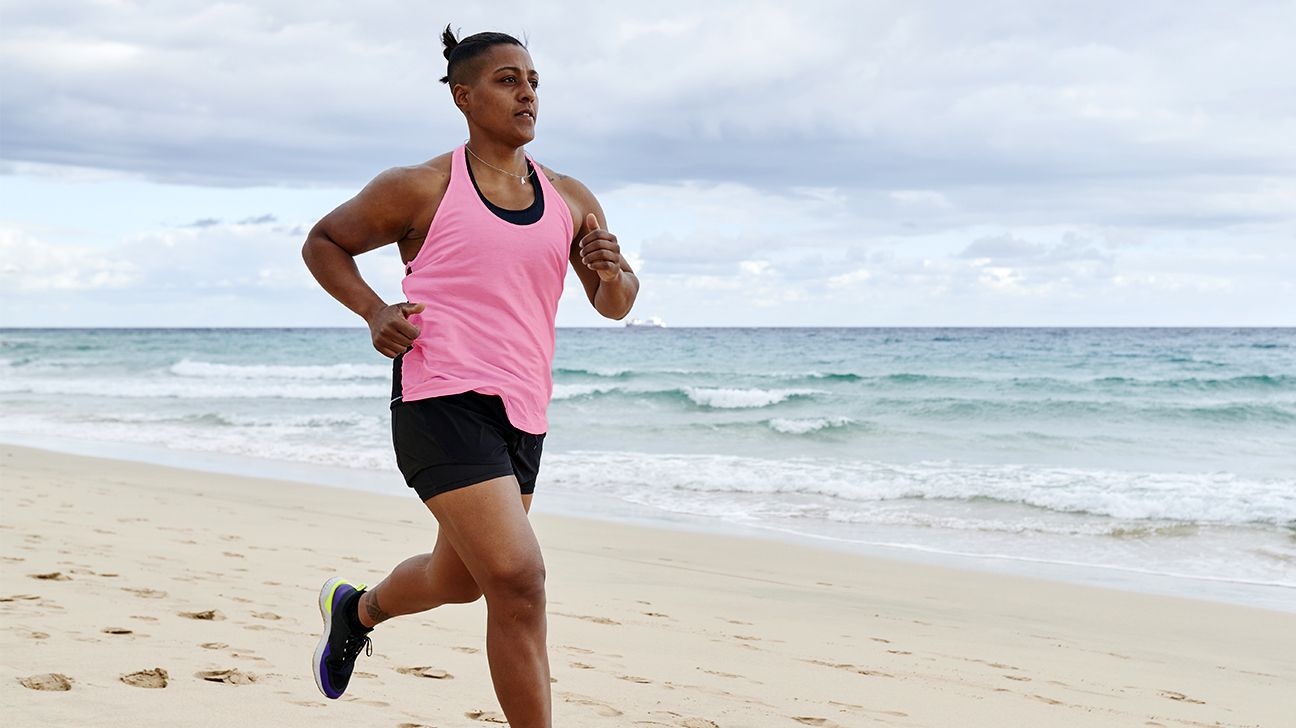Is your running motivation running short? It might be time to step out onto the sand. Whether you’re new to running or a lifelong pro, you can shake up your stale running routine with a trip to the beach.
7 tips for beach running
Beach running is a great way to challenge your muscles and get a little vitamin sea. Here’s how to get started.
- Begin with a full-body warmup.
- Lather on the sunscreen.
- Stay super hydrated.
- Run on the wet sand.
- Choose flat beach sections.
- Slowly ease into barefoot beach running.
- If you’re running with shoes, pick a quality pair.

It’s about more than a shoe with a view. Beach running comes with lots of health benefits and performance perks.
An extra challenge
Wanna add an extra dose of resistance to your miles? Beach running might be for you!
Sand’s an uneven surface, so it takes more energy from your foot muscles for you to keep moving your body forward, according to several studies. That makes your workout more challenging.
A softer landing space
Running on sand also means you’ll have a softer landing. It puts less stress on your ankles, knees, and hips, according to one small study. Another small study found fewer markers of post-workout muscle damage in people who ran on sand compared to folks who ran on grass.
A speed boost
Running on the beach may also improve your performance because it targets your muscles in different ways. One small study found that training on the sand led to additional fitness gains. That included better dynamic stability and a faster sprint time.
A bonus core workout
Beach running is also core-tastic! You need to keep your core muscles engaged when running to keep your balance. As you run on an unstable surface (like sand), your feet will slip and move. That means you’ll get even more of a challenge.
What’s so great about this dynamic stability boost? One small study suggested that core endurance training may make you a more efficient runner.
This is a bit of a hot topic. Some folks claim that running barefoot is the best thing ever, while others prefer to keep their shoes on.
Curious about running shoeless? Here’s how to figure out if it’s right for you.
The perks
- It may strengthen your feet.
- It might improve your balance.
The drawbacks
- You’ll have less protection from cuts or scrapes from shells (or broken glass).
- You’ll more likely experience blisters or burns.
- It could lower running stability.
Ready to switch the pavement for the sand? Check our top tips for making the best out of beach running.
1. Warm up
Every great workout starts with a strong warmup. Don’t skip this important step! It helps to prevent injuries. Before jumping into your exercise, make sure you spend a few minutes on a full-body warmup to get yourself ready to run.
2. Wear sunscreen
Skip the sunburn. Show your skin some love by wearing that broad-spectrum sunscreen. Complete your look with a pair of running sunglasses, and get those UV rays out of the way. Adios, radiation!
3. Stay hydrated
Drinking water is key to getting the most out of any type of workout. But it can be tough to get enough when you’re running outdoors in a hot temp. Make sure you stay hydrated, before, during, and after running with a handy reusable water bottle.
4. Start by running on wet sand
New to beach running? Start on wet sand. Wet sand is usually firmer, so it’s easier to find support than softer dry sand. This is also a great tip if you’re going barefoot. Don’t run without shoes on when the sand’s too hot. It can burn the bottoms of your feet.
5. Stick to flat ground
If you’re just getting started with beach running, try to avoid the dunes. Why? Running along a banked surface a could be a shortcut for future injuries.
6. Slowly ease into barefoot running
Wanna start barefoot running? Great! Just keep in mind that your body is used to being on shoes most of the time.
Running barefoot can come as a shock to your bod, and you might injure yourself. Ease into barefoot running by starting with short laps and then increase over time as your feet get used to it.
7. Be beach shoe ready
Not into the shoeless sprint? Find some comfy running shoes! If you have the budget, consider reserving a pair just for your beach runs. That way, you don’t have to try to get the sand out of your shoes, or wait for them to dry out before you can use them at the gym.
Beach running can be a scenic, fun way to explore new places. It can also save your workout routine from boredom and boost your athletic performance. Wanna start running on the beach? Just make sure to get a solid warmup, slather on the sunscreen, and stick to the flat ground. Ready, set, go!

